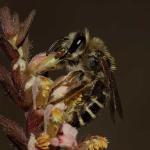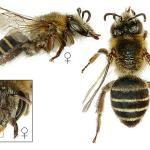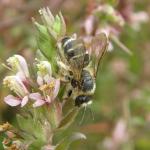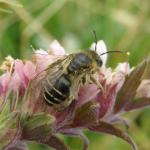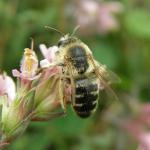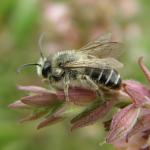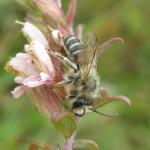Andrena microstigma EVERSMANN 1852; Andrena quadricincta EVERSMANN 1852; Melitta meridionalis HEDICKE 1933
At the time of year when many bee populations are declining, M. tricincta appears to be increasing, although it is generally only to be encountered around the inconspicuous flowers of red bartsia (Odontites vernus). In such situations it can be locally abundant and, as with other Melitta species, the males are usually more in evidence than the females.
In the British Isles, the species is apparently confined to southern England, South Wales (Glamorgan), and the Channel Isles (Alderney). However, its sole pollen source, red bartsia, is distributed throughout lowland Britain as far as the northern coast of Scotland. The plant is also found in the Western and Northern Isles, and is widely distributed in Ireland (Perring & Walters, 1962). The European distribution extends from Fennoscandia (where it is very rare) to Spain, and east to Romania or beyond.
Listed as a Nationally Notable (Nb) species by Falk (1991).
This species has a preference for chalk grassland and occasionally open broad-leaved woodland on chalky soils (the host plant, however, is not restricted to calcareous soils).
Univoltine; late July to early September, the flight period being closely synchronised with the flowering of the red bartsia.
The nest burrows are excavated in the soil, but are rarely found. In Dorset, S P M Roberts (pers. comm.) found a few widely scattered nest burrows in exposed, hard, compacted soil overlying chalk.
Both sexes visit red bartsia and, rarely, rest-harrow (Ononis repens) and water mint (Mentha aquatica), for nectar. The males fly low and actively around the flowers of red bartsia, only pausing occasionally for nectar.
None known, though it is likely that Nomada flavopicta may be a cleptoparasite of the species, having been found flying in the same site as M. tricincta and where its other known host, M. leporina, was apparently absent.
Profile written: 1998
Proofed: January 2012


